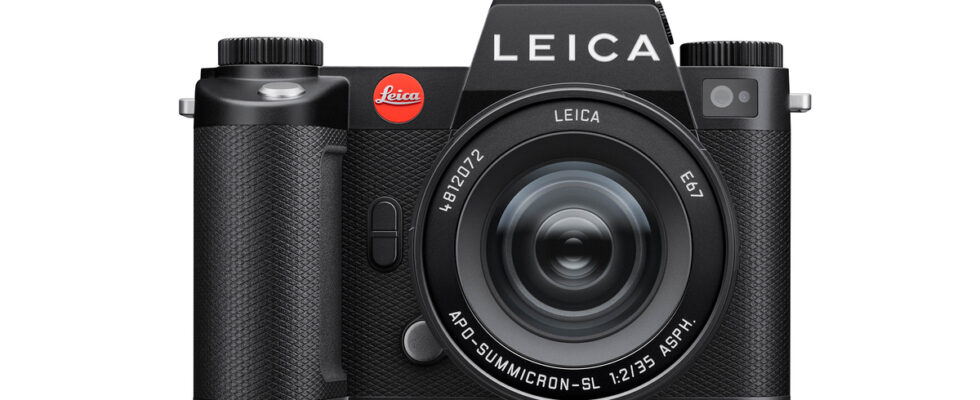Leica SL3
In the absence of offers discover
The links shown above may not work if an ad blocker is used.
At the start of 2024, Leica is giving birth to its third generation of hybrids with a 24×36 mm sensor with its brand new SL3. After the SL/Typ 601 (24 Mpx, 2015), the SL2 (47 Mpx, 2019) and its less defined variant SL2-S (24 Mpx, 2020), Leica moves up a gear by pushing further the definitions of picture. First of all, in photos, with a 60 Mpx sensor which comes close to the M11 and Q3. Then in video, since the SL3 is the first box from the brand to adopt 8K video.
60 MP sensor and 8K video
The 60 Mpx sensor inherited from the Q3. © Leica
In terms of electronics, Leica relies on its Q3 – a rational approach, most manufacturers developing a platform common to several cameras (like Fujifilm’s X-T5 and X100VI for example). From its large compact with fixed focal length, Leica recovers the Maestro IV processor, the 8 GB of buffer memory and the 60 Mpx sensor. It also adopts the BSI CMOS sensor (backilluminated), which displays a sensitivity range of 50 to 100,000 ISO and has the particularity of natively offering three output definitions (6, 36 and 18 Mpx). Something to reassure those who fear having to process (and store!) huge files.
The power of the new sensor processor as well as the definition of said sensor therefore make it possible to support 8K video (both classic 8K and cinema 8K, known as C8K), a first for a Leica hybrid camera. Which supports both h.265 codecs and Apple ProRes. In terms of speed, the device can push up to 600 Mbit/s… in 4K. According to Leica’s technical sheet, 8K only allows you to benefit from 300 Mbit/s internally, and you will therefore have to use an external HDMI recorder to go further.
If the box can already offer 600 Mbit/s, it is because Leica has redesigned the media partition. The memory controller and the card slots are evolving: Leica has maintained the SD UHS-II slot, but has transformed the SD UHS-I (slower) with a CF Express B. A much faster standard than the SD, which is the only one capable of handling large video streams.
A triple AF system… actually quite common
Leica highlights a new autofocus system which is based on three principles: contrast detection, phase correlation (dedicated photodiodes on the sensor) and the addition of depth mapping (depth mapping). The unknown being, as with any new product, the way in which the manufacturer has approached the parallel management of these three mechanisms of acquisition and monitoring of the subject.
While we can only welcome the improvement in Leica’s AF system, it is by no means new to the photographic industry. Indeed, apart from the fact that smartphones all use this technique – in particular to simulate background blurring in software – competing devices sometimes adopt it. In particular Canon bodies and their Dual Pixel sensors (since the EOS R and the Digic X processor).
Controls and internal software overhauled, viewfinder retained
On the top cover, still equipped with a liquid crystal screen, the untrained eye does not detect any changes. However, Leica has introduced a new dial on the left side which should delight photographers who need to change settings quickly.
The back of the device is well redesigned. On the one hand the buttons go from the left side to the right side. On the other hand, the 3-inch touch screen becomes — finally! — orientable. All without losing the IP54 certification dear to the engineers of the Wetzlar brand.
In terms of sighting, the 5.76 Mpx 120 Hz Oled panel and the optical part of the SL2 have been maintained, a viewfinder bearing the marketing name of EyeRes. While a jump in quality is always nice, it’s worth noting that the SL2’s viewfinder was already very good.
However, we notice some regressions in the body, such as the maximum electronic shutter speed, which is now 1/16,000th s compared to 1/40,000th for the SL2. The fault, undoubtedly, is the greater definition of the 60 Mpx sensor, which takes longer to empty its information than the 47 Mpx version. Another source of concern is autonomy. While the SL2 displayed 450 images with the BP-SCL4, the SL3 is only qualified for 270 images with the same battery.
If Leica specifies, both in the SL2 documentation (which we found) and in that of the SL3, that the cameras reach respectively 1400 (SL2) and 1350 images (SL3) according to another measurement method, but the first figure corresponds to the standard communicated by competing Japanese boxes. This raises fears that electronics will consume much more energy than the Japanese competition.
L mount: a more mature and diverse ecosystem than in 2015
In terms of optics, the SL3 will benefit, like its predecessors, from regular additions not only from Leica, but also from its acolytes within the L-Mount Alliance which are Sigma and Panasonic. An alliance that is good. While the first production model, the Leica SL Typ 601, had very few references to put under the bayonet, the SL3 can now benefit from several dozen references. It is therefore no longer a niche device or a vanity, but a tool that is part of a coherent system.
The other good news is the price (which remains high, we are with Leica!). While the first Leica SL Typ 601 launched in 2015 was positioned at a steep price for the time – €6,900 – the Leica SL3 seems measured with its €6,800. A price lower by €100 (impressive when you know the level of inflation) which is perfectly audible compared to the Z9 and other A9 Mark IIIs. Especially in a market where prices continue to rise, and where €5,000 represents the entry threshold into the world of pro devices.
The Leica SL3 is available today at €6,800 bare body.
